If you want to make the most of your time this Holy Week to reflect upon your faith in Jesus Christ and the mystery of his life, death, and resurrection – away from Manila but near enough to allow you to get home afterwards – look no further than Cavite.
Your guide to these “Faith Tourism” destinations south of Manila is a book featuring Cavite’s ten venerated images of the Virgin Mary and the century-old churches which serve as their homes.
The Virgins of Cavite: History, Art and Religiosity, researched and written by De La Salle University – Dasmariñas’ Teresita P. Unabia, Bernardo N. Sepeda, EdD and Rosanni R. Sarile describe the value of the churches and the images of Virgin Mary.
“Cavite was appropriately called Tierra de Maria Santisima (Land of the Most Holy Mary) in the last quarter of the 16th century… inspite of the seeming plurality of titles, endearing names, feast days, and devotional rituals, Mary still is a “unifying force” manifesting singularity in the religiosity and/or spirituality among the Caviteños,” according to the book.
The Cavite Studies Center publication presents the Marian images and their churches as follows:
1. Nuestra Señora de la Soledad de Porta Vaga in the Parish of San Roque, Cavite City
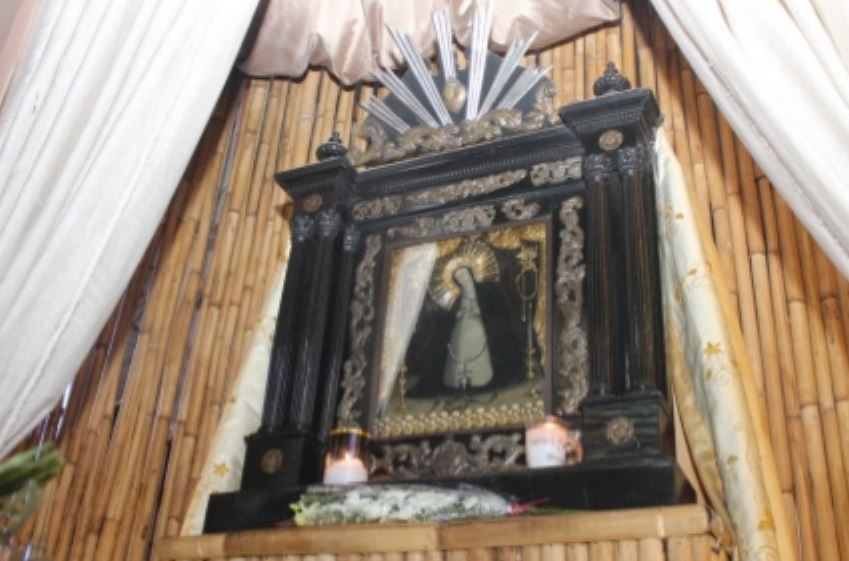
The Nuestra Señora de la Soledad de Porta Vaga in San Roque, Cavite City is one of the canonically crowned Marian Images in the Philippines. She was crowned on November 17, 1978 by Most Reverend Bruno Torpigliani, Papal Nuncio.
“Legend narrates one stormy night while at a detachment of the Spanish Guardia Civil stand post, a dazzling apparition rose from the currents of Cañacao Bay. Suspecting pirates, the sentinel shouts “Stop!” Instead of stopping, the light proceeds toward him. The sentinel shouts again “Who is there?” He hears a sweet voice “Little soldier, why halt me on a night so cold? Let me pass. Dost thou not recognize Mary?” The next morning fishermen find a framed image of the Virgin near Vaga Gate. They bring the image to the parish priest who installs it in the parish church.” At the back of the image is this statement: “A doze de Abril 1692 años puzo esta S(antissima) Y M(ilagrosa) himagen haqui por Juan de Oliba.
The Nuestra Señora de la Soledad de Porta Vaga is a painting of the Mother of Jesus on a piece of a tightly-woven fine linen. Clad in morning clothes, she is on a kneeling position and contemplating. The image has metallic decoration.Accordingly, the original wood frame is encrusted with silver representation of the ladder; the Cross draped with a shroud, the key and rooster, recalling the denial of St. Peter; the pitcher from which water was poured to wash Pontius Pilate’s hands; the sponge mounted on a stick used to wet Jesus’ lips with vinegar; the reed they mocked Him with; mast, symbolizing the blindfolding of Christ; the pillar where Christ had been tied; the handkerchief used by Veronica to wipe Christ’s face.
2. Nuestra Señora del Rosario in the Parish of Rosario
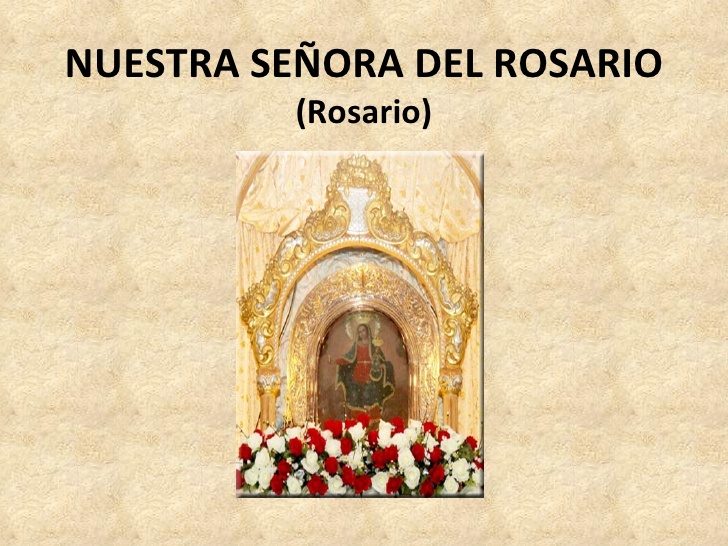
Nuestra Señora del Rosario is the patroness of Rosario, one of the pueblos bajos erected at the turn of the 19th century. The Virgin was enthroned on the same date that the town was created by virtue of Narciso Claveria y Zalduas’ decree on October 22, 1845. Nuestra Señora del Rosario had its coronation on October 7, 1995.
According to the narrative of Don Catalino Abueg and his wife, Doña Rosa Ner, it was a stormy morning on a first Saturday of October 1845, the “captain” of a batel (a boat) and his crew met strong wind because of a typhoon on their way to Manila. He asked his crew members to tie themselves to the boat so that they won’t get lost or separated from each other. The captain went inside to save whatever he could. He saw the framed image of Our Lady of the Most Holy Rosary. He called his crew and when no one answered him, he prayed: “Mag-inang Mahal na Nuestra Señora del Rosario, tanang kasakasama namin sa lahat ng aming paglalakbay, iligtas po Ninyo kami at kahit na po saan mang panig ng daigdig Ninyo kami ipadpad ng buhay, ay ipinangangako ko po na Kayo ay aming ipagpapagawa ng isang bisita (tuklong) or a chapel, at sa mga taong aming dadatnan ay buong puso namin Kayong ilalagak at iiwan.” The next morning, Sunday, the batel reached the seashore of Muzon, part of Salinas then. From what remains of their sea vessel the crewmen constructed an altar of bamboo on the land owned by Teniente Felix Suasa and his wife Sibrena where they later enthroned the image of Nuestra Señora del Rosario. The Virgin was accepted by the people.
3. La Inmaculada Concepcion in the Diocesan Shrine and Parish of Naic

Naic was a visita from 1693 – 1768 under the spiritual jurisdiction of Nuestra Señora de la Asuncion in Maragondon. The parish was created independent with the Immaculate Conception as patroness in 1796. When Fr. Modesto de Castro, a Filipino secular priest and rector of the Manila Cathedral was assigned in Naic in 1857, he built a convent made of stone. It was inaugurated in 1861 by Fr. Mariano Gomez. The Dominicans took over the administration of the parish in 1865. They built a bigger church and convent. A small portion of the church was partly destroyed during the Second World War. The church was dedicated by Ricardo Cardinal Vidal, DD on November 17, 1996 during the bi-centennial of the parish and on December 8, 1996, it was declared a Diocesan Shrine by Bishop Manuel Sobreviñas.
The image of La Inmaculada Concepcion in the Parroquia y Santuario Diocesano De La Immaculada Concepcion in Naic is de bulto. It was made out of wood.
4. Nuestra Señora de la Asuncion in the Parish of Maragondon
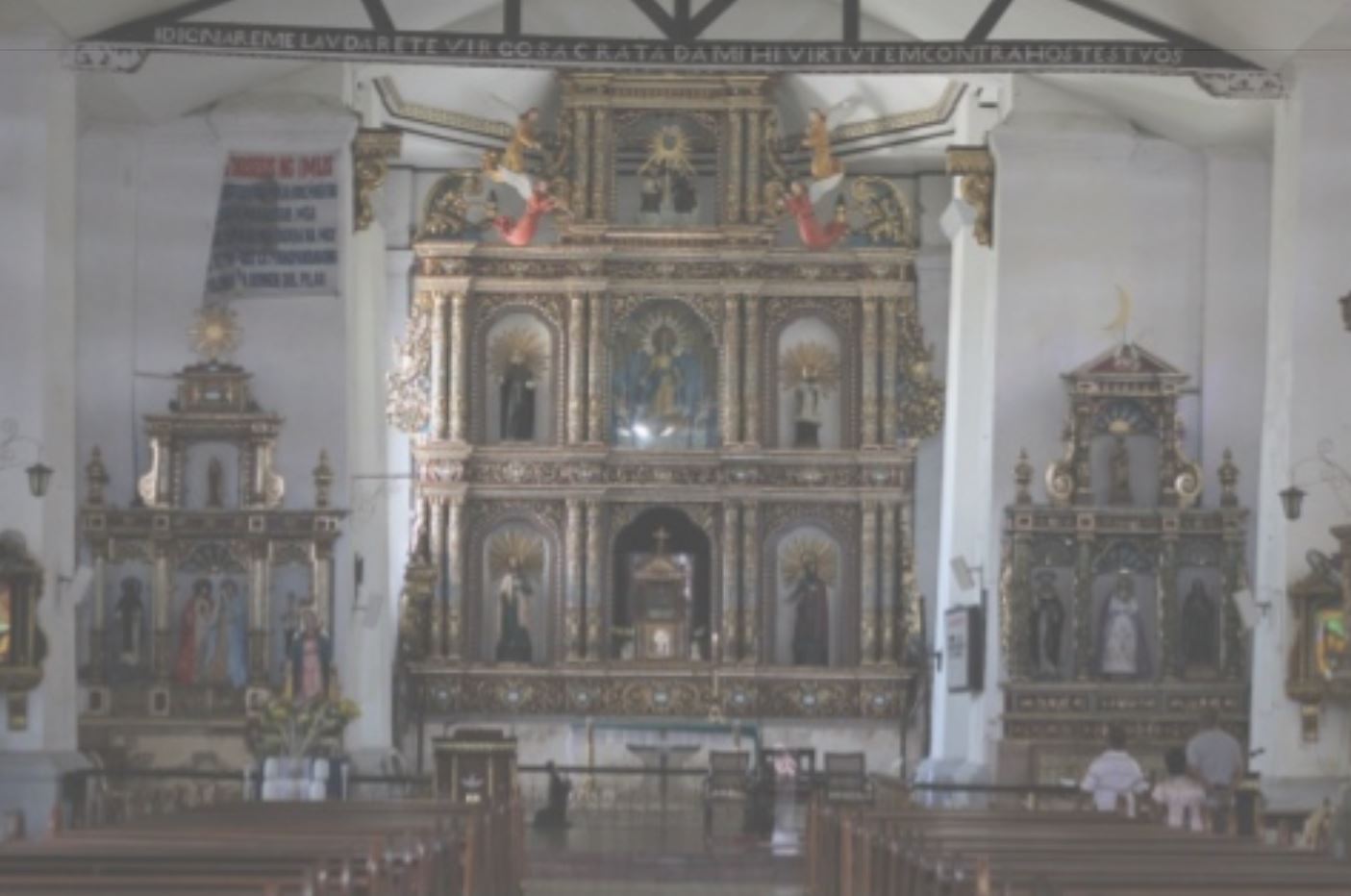
There are three statues of the Nuestra Señora De la Asuncion in the Parish of Maragondon. One is the original image with missing fingers, and enigmatic or engaging look because the Virgin Mary seems to be smiling from its left side, but from its right, she appears solemn. The second image is the Birheng Nakatayo. This standing Virgin Mary is in the retablo of the church. The image looks up at the heavens. The statue was carved out of kamagong. Its face and hands are made of ivory. Though the parish was officially established in 1627, the image was purchased as early as 1620 for seventy pesos (P70.00) by the faithful of Maragondon.The third is the Birheng Nakaupo or seated Virgin Mary.
5. Nuestra Señora de Guia in the Parish of Magallanes
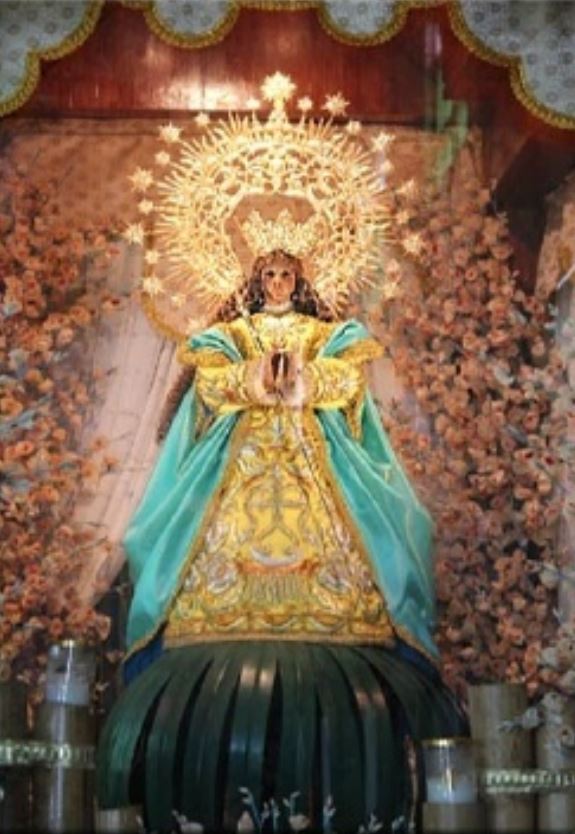
The old image of the Nuestra Señora de Guia of Magallanes, Cavite, is “yari sa garing”, made of ivory, but it disappeared. The present image is made of wood. It has undergone repair. The base was changed from a cloud-like to a pandan pedestal. Seemingly, the present image of Our lady is “selosa” or jealous of the viajera because the replica was burned before it can be brought out for the Flores de Mayo festivity. The Parish Magallanes was created by a Royal Order on September 10, 1880. It was the last town founded in Cavite in the 19th century. Because of the intense devotion of the people to the Nuestra Señora de Guia which the king of Spain proclaimed as the Patroness of Manila in 1758, it was also bestowed as the Patroness of Magallanes. The Parish of Magallanes was established on March 3, 1882 based on a “Real Orden” and approval of Msgr. Pedro Payo, Archbishop of Manila. However, a marker on the left side of the church states “Parroquia De Magallanes Cavite Fundada En El Año 1883.”
6. Our Lady of Lourdes in Our Lady of Lourdes Parish, Tagaytay City

The Blessed Virgin Mary wears a white garment from head to toe with a sky blue sash on the waist. She has a crown of 12 stars, a rosary hanging on her arm and a rose on her foot. She appeared to Bernadette Soubirous at Lourdes, France from February 11 – July 16, 1858. On January 18, 1862 the apparition was declared authentic by the Bishop of Tarbes. In 1890, the liturgical feast of Our Lady of Lourdes was established for February 11. It was approved by Pope Leo XII and first granted to the Diocese of Tarbes. On November 13, 1907, Pope St. Pius X proclaimed that the feast be observed throughout the universal Church. The Capuchins bought a piece of land in Tagaytay on October 14, 1938. A small wooden house was built to be the resthouse of Capuchin missionaries. Seeing the need of the people for spiritual nurturing, the Capuchins opened a public oratory for the faithful of Tagaytay to take part in the liturgical services of the friars.
7. Nuestra Señora de Candelaria in the Parish of Silang
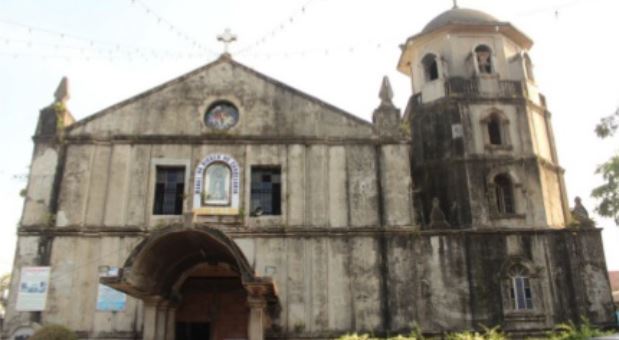
The image of the Nuestra Señora De Candelaria, patroness of the town of Silang, at the facade of the church structure is described as a polychromed. On the other hand, the statue in the main retablo is of hardwood sculpture de bastidor. Based on the origin myth, the image of the Blessed Virgin was found by Andres, a native, in the mountains of Silang in 1640. The beauty of the Lady captivated a friend of Andres and asked for it. A temporary place of worship was built for her. People were awed. They gathered together and prayed. One time, the man failed to observe the sacredness of a Friday as mentioned to him by his folks. He went on a journey. Upon his return, the image of the Virgin was nowhere to be found. He searched, found her and the faithful asked forgiveness. The Nuestra Señora was brought home. After eight other disappearances, the image was placed on the retablo at the gospel side.
8. Our Lady of La Salette in the National Shrine in Biga I, Silang
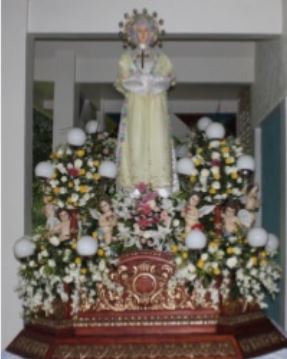
The National Shrine of Our Lady of La Salette was a promise fulfilled by Fr. Fred Julien, M.S. Fr. Julien promised Our Lady to erect a shrine in her honor should she help him survive the battle among US paratroopers and Filipino guerrillas against the Japanese soldiers that morning on February 23, 1945. He was among the internees in Los Baños, Laguna. Miracles happened. Not one of the two bishops, two hundred forty three priests, nuns, brothers and more than two thousand Protestant missionaries were killed. He was deported to United States of America (USA). After seventeen years Fr. Julien was allowed to return to the Philippines by Fr. Alphonse Dutil, the Superior General, but it was Fr. Paul Douillar, the Vice Provincial who told him: “You may go to Silang to fulfill your promise but we can give you neither money nor help.”
The life-size statue of Our Weeping Mother as part of the National Shrine of Our Lady of La Salette in Biga I, Silang, Cavite was sculpted out of large pieces of granite by two stonecutters from Manila. On September 10, 1968 the sculpture was finished and the next day September 11, the novena to Mary, Queen of La Salette, began. Accordingly, the exact measurements of the shrine in La Salette France were obtained and copied.
9. La Immaculada Concepcion in the Parish of Dasmariñas

The Royal Order creating the Parroquia De Perez-Dasmariñas was signed by Queen Isabella II on October 21, 1862 under the administration of the Order of Recollects of Saint Augustine. The parish was placed under the patronage of the Immaculate Concepcion whose image was sculpted by Esperidion Arevalo of Sta. Cruz, Manila. It was installed in 1867. On December 7, 2002, Most Rev. Bishop Emeritus Manuel Sobreviñas, DD, led the Symbolical Coronation of the Blessed Virgin during a concelebrated mass. The next day, December 8, Most Rev. Bishop Luis Antonio Tagle, DD, was the principal celebrant during the Dedication of the Church themed Si Maria, La ‘Purissima’ Inmaculada Concepcion, Reyna ng Pamilyang Dasmarineño.
10. Nuestra Señora del Pilar in the Parish of Imus

The image of the Nuestra Señora del Pilar was brought to the Philippines from Spain by Rev. Fr. Martin Lumbreras Sanchez Perez Peralta, OAR, in 1623. It was first enthroned on a small altar in the Church of San Nicolas de Tolentino at Intramuros, Manila. On May 28, 1694, the Recollect friars transferred the image of the Virgin of the Pillar to the Casa Hacienda de Imus. A plan to construct a church in the Hacienda in honor of the Virgin was approved on March 13, 1766. More than thirteen (13) years after, on September 27, 1779, the new church was finished and the image of Nuestra Señora del Pilar was enth09roned in the main altar. Nuestra Señora del Pilar became the patroness of the Parish of Imus when it separated from the spiritual jurisdiction of the Jesuits of Kawit, the mother town, on October 3, 1795. With the separation of the Diocese of Imus from the Archdiocese of Manila on November 25, 1961, the Nuestra Señora del Pilar was declared as Titular Patroness and Protectress of the whole diocese and of the whole Province of Cavite.
The Virgins of Cavite: History, Art and Religiosity can be viewed in video format here:













